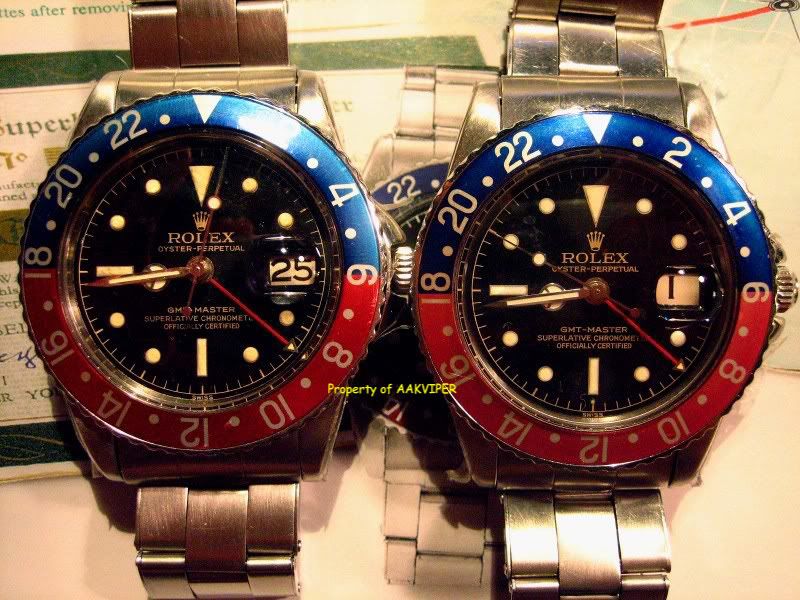Let us look at it this way, without an underline on the 3 x Swiss GMT and added Swiss-T<25>Now for me the underline makes it further from the being a reluming symbol then ever. As we have seen and proven on Patek's and early non sport's model.
So far I have seen about four 3x Swiss GMT with this dial variation ranging form 10xxxxx to 11xxxxx serial numbers. One has to look at a micro close up of this are GMT dial to see that it has an Swiss in gold font just under the white Swiss. Very neat. The white Swiss print, silver Swiss->T 25, and two gold gilt print for the rest of the dial. Three different print colors. Wild!
What makes this dial so significant is the indisputable evidence of the actual years and timeline when the Swiss dials changed over to Swiss-T< 25. Thus by logic Rolex switched from radium to tritium. So in my opinion the underline dial was definitively not a symbol for the radium to tritium lum change over, but for the centering of the dial print.
The missing link GMT below without the underline but with Swiss in gold white AND in gold while displaying the Swiss- T<25
As with the unique Bonhams 3-6-9 the 3 x Swiss GMT, Rolex did advertise the new lum material but by not an underline symbol, more like a specifically clear undeniable symbol such as the Swiss-T<25




One will find in this segment a general overview of the GMT pointed guard model. I did not bring forth extreme particulars in order to help the newer collector to better understand this specific GMT model. So I omitted close up scans and amply explaining the nuances of dials, case backs, calibers, and variations within this model line.
Besides the 6542 no crown guard GMT, the early 1675 pointed guard is next sought after of the GMT from a long line of GMT lineage.

The pointed guard nomenclature adverts to the crown area guard, which is part of the case. This area was added to protect the crown as on the Submariner models from impacts that would possibly compromise the crown's waterproof status. The 1675 GMT had two types of crown guard designs during it's production run. The fist generation being the pointed guard version, so called because of it's pointed peck design and the later being a square crown guard design. Both versions were produced a number of years at the same time.
A side view of a 1675 pointed guard case

The pointed guard came into production around 1959 and ended production around 1966. All pointed guard models which I have seen housed the GMT 1560 slower beat caliber.
The GMT 1560 slower beat caliber in the picture below.

The early case back..

The fast beat 1570 GMT caliber was housed by the newer square guard 1675.
The early 1675 pointed guard versions received a black gloss "Swiss" marked dial with outer chapter ring and gold gilt font dial with a small 24 hour hand.

By 1964 the gloss gold gilt dial and small 24 hour hand were still the standard, but with no outer chapter ring and now the Swiss-T<25 added.="" br="" mark="" was="">

The 1675 pointed guard series received from the Rolex factory an expansion and non expansion oyster bracelet or in the mid 1960's a SS Jubilee bracelet.
The 1675 GMT black matte with white fonts and gold gilt dials were both available on the next generation 1675 square guard GMT..but the matte dial was not found on the 1675 pointed guard model.
